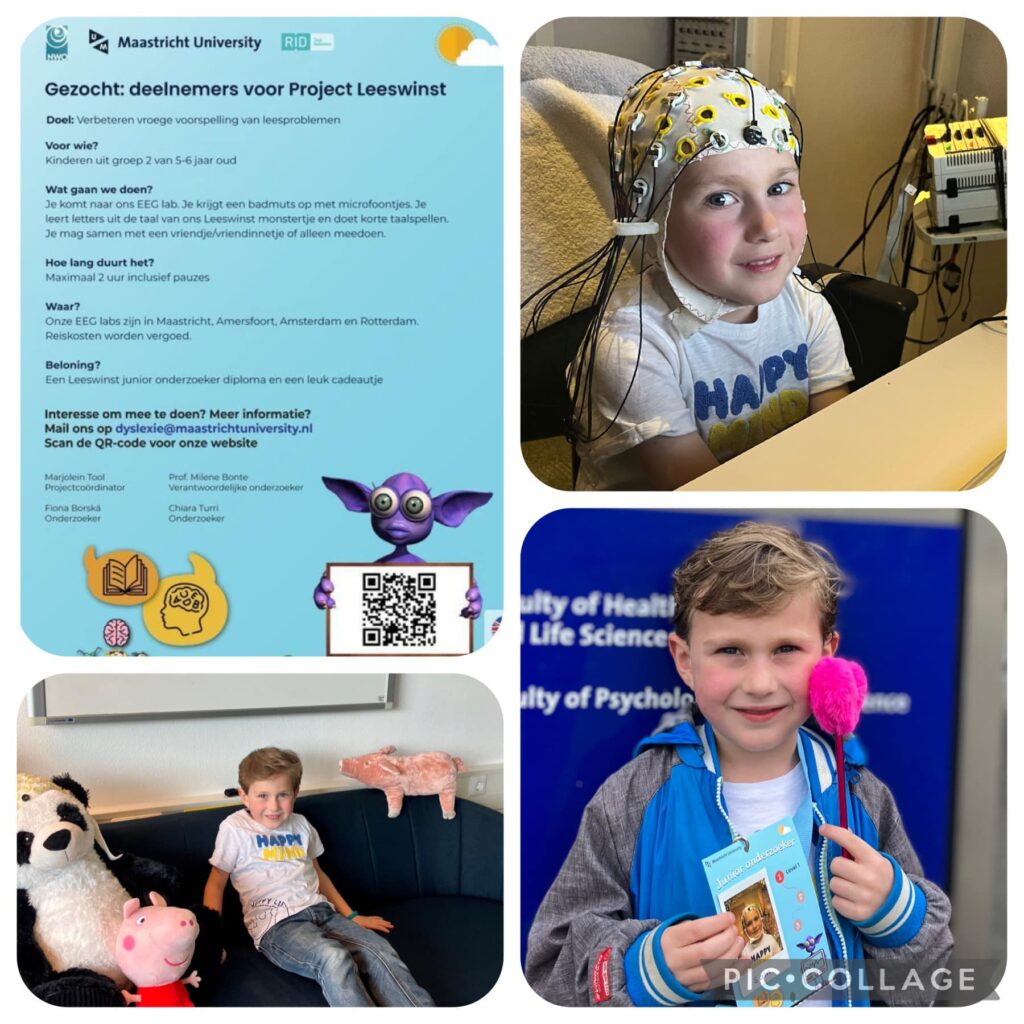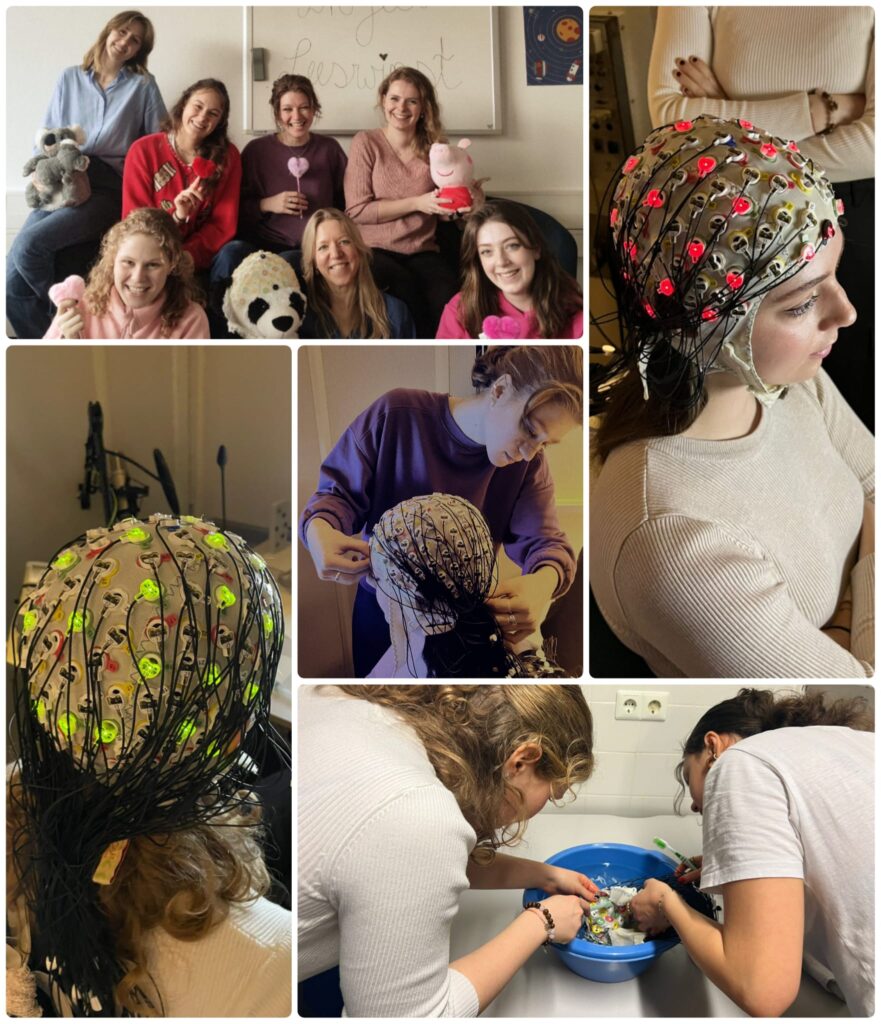First results Project Leeswinst
Comments Off on First results Project LeeswinstIn Project Leeswinst, we aim to improve early detection of reading problems by developing a learning task where children learn to pair new letter-like symbols to speech sounds. We investigate how children learn these new letters and how their brain activity changes during this learning. With this knowledge, we will develop a digital learning test that predicts who will learn to read fluently and who will need extra support to prevent reading problems.
We are very happy that 67 children already participated as junior researchers in our study and that other children will still join this summer. A sneak peek of our first results shows that children indeed show large differences in learning the new letters. Interestingly, children with and without a family member with dyslexia did not differ in letter learning. We do see that children with a family member with dyslexia tend to score slightly lower when asked to recognize which words start or end with the same sound (for example: boom | doos – raam – tak – wieg).
How did children’s brain activity change while they were learning the new letters? Faster learners show greater activity changes in brain regions that are important for reading development. For example, in audiovisual areas and in the frontal cortex, which is involved in attention skills.
The first children have now come back to visit our labs in Maastricht, Amsterdam and Amersfoort for the follow-up (level 2). We are excited to discover what the children have learned this year and whether our letter learning task is indeed a good predictor of reading problems. This summer, we will also start an fMRI study in Maastricht to better understand how the brain of 8–12-year-old children with/without dyslexia changes during letter learning.
We thank all participating families and schools for their support and look forward to sharing more results as the project continues!
Interested in participating? Go to our get involved page!
Wanted: schools (groep 2/3) for Project Leeskans
Comments Off on Wanted: schools (groep 2/3) for Project LeeskansWould your school like to help improve the early detection of reading difficulties, self-image, and reading motivation? We are looking for students at the end of kindergarten / beginning of first grade (equivalent to Dutch group 2/3) who would like to try out our educational game!
What does it involve?
- Schools share our information letter with parents
- Children participate in the study if parents give consent
- We will come to your school for the research (2 sessions of 30 minutes per child, individual assessment)
- School visits are scheduled in consultation, between mid-April and October 2025
Where does the research take place?
We will come to your school!
How can your school participate?
Send an email to dyslexia@maastrichtuniversity.nl or sign up via this form.
Do you also want to participate? (video)
Comments Off on Do you also want to participate? (video)We are super happy with all children that have participated in our research project: Leeswinst! The video below gives you an impression of the EEG sessions. Does your child also want to participate in our study? Please contact us through dyslexie@maastrichtuniversity.nl or our “Get involved” page!
We are looking for children in groep 3 for ‘Project Leeswinst’!
Comments Off on We are looking for children in groep 3 for ‘Project Leeswinst’!The new school year has begun! Until now, a lot of children from eind groep 2 have participated in our study. This school year we are looking for children in groep 3 (5-7 year old children). Do you want to contribute to the early prediction of reading problems? Please participate in our research project!
What are we going to do?
- You visit our EEG lab. Your child will wear a swimming cap with microphones.
- Your child will learn letters from our Leeswinst monster’ language and play short language games.
- Your child can participate together with a friend or alone.
- It will take about 2 hours including breaks.
- We will make it a fun trip! See our Facebook and Instagram pages for an impression.
What is the reward?
- Leeswinst junior researcher diploma
- A nice gift
- Travel expenses wil be reimbursed
- In 2025-2026, we will organise a child symposium in which we share the results of our study with parents and children.
Where are our EEG labs?
In Maastricht, Amersfoort en Amsterdam
How can I participate?
Send an e-mail to dyslexie@maastrichtuniversity.nl of fill in the form on https://mbic-languagelab.nl/onderzoek/
Start Project Leeswinst
Comments Off on Start Project LeeswinstIn April, we started the first measurements in Amersfoort and Maastricht. We are super happy with our first ‘junior researchers’! One of the participating parents shared a great impression on LinkedIn and Facebook.
Do you have a child in groep 2? Then sign up for Project Leeswinst via dyslexie@maastrichtuniversity.nl or via the ‘Get Involved’ button on the website!

Team training Project Leeswinst
Comments Off on Team training Project LeeswinstIn February, the research team of Project Leeswinst came together for a training day! Our team of students, PhD candidates, and coordinators went through all procedures together and practiced on each other. We were trained for EEG data collection and administering neuropsychological tests on children. We specifically focused on ways to make the research as enjoyable and comfortable as possible for young children. For instance, with children, we use a smaller EEG cap with fewer electrodes and demonstrate the cap application first on a stuffed toy.
Due to the diverse backgrounds of our team members, everyone was able to contribute in their own way to the training. It was an informative day, and we are looking forward to kicking off with our enthusiastic team!

Wanted: participants for ‘Project Leeswinst’!
Leave a CommentWould you like to contribute to the early prediction of reading problems? We are looking for 5, 6 and 7 year olds (groep 2 and groep 3) to participate in our study!
What does it involve?
- You are invited to visit one of our EEG labs.
- Your child can participate together with a friend or alone.
- Your child learns letters from our Leeswinst monster’s language and plays language games.
- Together, we will make this a fun experience!
What’s in it for you?
- Our Leeswinst junior researcher diploma
- A nice gift
- Travel expenses will be reimbursed
Where are our EEG labs?
In Maastricht, Amersfoort, Amsterdam en Rotterdam
How can we participate?
Send an e-mail to dyslexie@maastrichtuniversity.nl of fill in the form at https://mbic-languagelab.nl/onderzoek/
Predicting reading problems before children can even read
Comments Off on Predicting reading problems before children can even readMore and more children in the Netherlands have a problem with reading. How can this be detected as early as possible? That is what Maastricht neuroscientist Milene Bonte is trying to find out. Recently, she was the only UM researcher who managed to obtain a Vici grant, worth one and a half million euro.
Milene Bonte received NWO Vici grant
Comments Off on Milene Bonte received NWO Vici grant
Milene Bonte received a Vici grant of 1.5 million euros from the Netherlands Organisation for Scientific Research (NWO). With the grant she will set-up a 5-year research project to develop novel measures for improved early screening and prevention of reading difficulties. The novel screening measures will be investigated in children with and without family members with dyslexia.
We extend our congratulations to Milene Bonte and look forward to seeing the valuable contributions that the research will make to understanding individual differences in reading development and prevention of dyslexia!
Results Project Leeswinst: the first behavioural and (f)MRI findings
Comments Off on Results Project Leeswinst: the first behavioural and (f)MRI findingsWhen a child learns to read he/she needs to learn to correctly combine text and corresponding speech sounds (e.g. the letter ‘a’ and the speech sound /a/). Scientific studies have shown that it may exactly be this combination of text and sound that is difficult for children with dyslexia and leads to their reading problems. In project Leeswinst we want to understand why this is the case and how brain responses to letters and speech sounds change when children with and without dyslexia improve their reading skills over time. A group of seventy 8-10 year old children visited our MBIC lab to perform an ‘aba’ ‘ada’ task on the computer and in the MRI scanner. In the ‘aba’ ‘ada’ task, the children hear an ambiguous speech sound that is sometimes perceived as /aba/ and sometimes as /ada/. Together with this speech sound they see ‘aba’ or ‘ada’ text on a computer screen. Children’s task performance and brain activity tells us how they combine letters and speech sounds.
The first results of our project surprisingly show a similar performance in children with and without dyslexia, apparently indicating a similar coupling of the ambiguous sound and ‘aba’ or ‘ada’ text. However, children’s brain activity as measured in the MRI scanner reveals some interesting differences. Children with dyslexia show significantly less activation in a visual brain area specialized for text (brain area in pink in the picture below) compared to typically reading children. Moreover, regardless of dyslexia diagnosis, this area was less active in children with worse reading skills and worse performance on a task with speech sounds. We also observed that children who are slower in combining letters and speech sounds, have less activation in auditory brain areas that are important for creating letter speech sound combinations (brain area in blue in the picture below). Together these results show that individual differences in children’s reading skills relate to the way in which auditory and visual brain areas process speech sounds and letters. The next important question is now whether and how these brain areas changed when the same children came back to our MRI lab one year later and again performed the same ‘aba’ ‘ada’ task. We are looking forward to presenting these follow-up results in the coming months.
Project Leeswinst poster presentation in Helsinki
Comments Off on Project Leeswinst poster presentation in HelsinkiWe were happy to present the findings of our research project at the Eleventh Annual Meeting of the Society for the Neurobiology of Language which took place August 20-22 in Helsinki, Finland.
We got inspired from fellow researchers investigating language and reading processes and received compliments as well as insightful comments and suggestions for our project.
You may find a digital copy of the poster here:
Conference location – Finlandia Hall
Kindercongres Leeswinst a success
Comments Off on Kindercongres Leeswinst a successProject Leeswinst poster presentations
Comments Off on Project Leeswinst poster presentationsWe have recently presented the findings of project Leeswinst in the SIG22 Neuroscience and Education conference in London in June and Flux: The Society for Developmental Cognitive Neuroscience meeting in Berlin in September. Our preliminary findings show that parts of the brain that we use for speech perception were less active in dyslexic children, while brain regions typically associated with more effortful, letter-by-letter reading were more active compared to typically reading children. The findings were well received and gave us new ideas on how to further analyse and present our fascinating data.
You may find the posters here:
DOI: 10.13140/RG.2.2.35658.21448
DOI: 10.13140/RG.2.2.11331.25127



